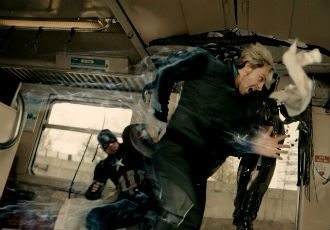 Beijing – May 28, 2015 – Blackmagic Design today announced that Marvel’s “Avengers: Age of Ultron” 2nd Unit shot extensively on the Pocket Cinema Camera. Joss Whedon’s highly anticipated sequel to “Marvel’s The Avengers” was lensed by cinematographer Ben Davis (“Guardians of the Galaxy”).
Beijing – May 28, 2015 – Blackmagic Design today announced that Marvel’s “Avengers: Age of Ultron” 2nd Unit shot extensively on the Pocket Cinema Camera. Joss Whedon’s highly anticipated sequel to “Marvel’s The Avengers” was lensed by cinematographer Ben Davis (“Guardians of the Galaxy”).
When Tony Stark tries to jumpstart a dormant peacekeeping program, things go awry and Earth’s mightiest heroes are put to the ultimate test, as the fate of the planet hangs in the balance. As the villainous Ultron emerges, it is up to the Avengers to stop him from enacting his terrible plans, and soon uneasy alliances and unexpected action pave the way for an epic adventure.
The film differs quite significantly from the original Avengers movie. “The first was about a coming together, whereas this film is about a coming apart, which is reflected in the tone of the script,” explains Ben. “The narrative of the film is far more dark and menacing, so the visual approach was grittier, darker and more earthbound.”
“Avengers: Age of Ultron” features an extensive amount of 2nd Unit work and Davis required a small, high quality digital film camera for the film’s stunt sequences. “I was a big fan of what Anthony Dodd-Mantle had achieved on “Rush” using small camera platforms, especially when it came to mounting them in unusual places and the shots he was able to achieve,” he reveals. “I decided to get a Pocket Cinema Camera in for testing after bumping into DIT friend of mine who’d recently purchased a one, and was raving about it. For me, it was a no-brainer really, it was all about the latitude and size. Suddenly I had a small camera which not only output a 12-bit RAW image, but it also had a latitude that was getting up to and around the level of high end digital cinema film cameras.”
“There are two large battle sequences in particular during the film, the first is at the beginning and the second features in the third act, and we very much wanted these to be shot as a war correspondent would cover news in a conflict zone. What we needed was a lightweight camera that we could then distribute around the set during the filming of battle sequences that would give us more than twelve frames of good quality HD material that we could match with our main camera package. For this we used eight Pocket Cinema Cameras paired with either a 14mm pancake lens or a 12-35mm zoom, which we then mounted to impact points around the set. Say for example a truck was being blown up and thrown through the air and we wanted to capture it landing on top of a car, we would put one of the Pocket Cinema Cameras in a small metal housing and put it in the car. Another instance involved mounting the Blackmagic camera to a tank, because we could literally strap it one on the end of a magic arm and bolt it to almost anywhere we wanted it to be on the tank.”
“When I got the Pocket Cinema Cameras in I thought they would be a nice to have, however I ended up using these far more than I ever thought we would,” concludes Ben. “The appealing thing about this camera is its size to quality ratio. The footage is usable for a much longer cut time than previous incarnations of small camera platforms and so the camera does in fact become far more useful.”
Press Photography
Product photos of the Blackmagic Pocket Cinema Camera are available at www.blackmagicdesign.com/
About Blackmagic Design
Blackmagic Design creates the world’s highest quality video editing products, digital film cameras, color correctors, video converters, video monitoring, routers, live production switchers, disk recorders, waveform monitors and real time film scanners for the feature film, post production and television broadcast industries. Blackmagic Design’s DeckLink capture cards launched a revolution in quality and affordability in post production, while the company’s Emmy™ award winning DaVinci color correction products have dominated the television and film industry since 1984. Blackmagic Design continues ground breaking innovations including 6G-SDI and 12G-SDI products and stereoscopic 3D and Ultra HD workflows. Founded by world leading post production editors and engineers, Blackmagic Design has offices in the USA, UK, Japan, Singapore and Australia. For more information, please go to www.blackmagicdesign.com.
